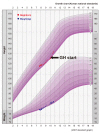Ann Pediatr Endocrinol Metab.
2017 Jun;22(2):129-132. 10.6065/apem.2017.22.2.129.
2q37 Deletion syndrome confirmed by high-resolution cytogenetic analysis
- Affiliations
-
- 1Department of Pediatrics, Samsung Medical Center, Sungkyunkwan University School of Medicine, Seoul, Korea. nadri1217@naver.com
- KMID: 2383909
- DOI: http://doi.org/10.6065/apem.2017.22.2.129
Abstract
- Chromosome 2q37 deletion syndrome is a rare chromosomal disorder characterized by mild to moderate developmental delay, brachydactyly of the third to fifth digits or toes, short stature, obesity, hypotonia, a characteristic facial appearance, and autism spectrum disorder. Here, we report on a patient with 2q37 deletion presenting with dilated cardiomyopathy (DCMP). Congenital heart malformations have been noted in up to 20% of patients with 2q37 deletions. However, DCMP has not been reported in 2q37 deletion patients previously. The patient exhibited the characteristic facial appearance (a flat nasal bridge, deep-set eyes, arched eyebrows, and a thin upper lip), developmental delay, mild mental retardation, peripheral nerve palsy, and Albright hereditary osteodystrophy (AHO)-like phenotypes (short stature and brachydactyly). Conventional chromosomal analysis results were normal; however, microarray-based comparative genomic hybridization revealed terminal deletion at 2q37.1q37.3. In addition, the patient was confirmed to have partial growth hormone (GH) deficiency and had shown a significant increase in growth rate after substitutive GH therapy. Chromosome 2q37 deletion syndrome should be considered in the differential diagnosis of patients presenting with AHO features, especially in the presence of facial dysmorphism. When patients are suspected of having a 2q37 deletion, high-resolution cytogenetic analysis is recommended.
Keyword
MeSH Terms
-
Autism Spectrum Disorder
Brachydactyly
Cardiomyopathy, Dilated
Chromosome Disorders
Comparative Genomic Hybridization
Cytogenetic Analysis*
Cytogenetics*
Deoxycytidine Monophosphate
Diagnosis, Differential
Eyebrows
Growth Hormone
Heart
Humans
Intellectual Disability
Muscle Hypotonia
Obesity
Paralysis
Peripheral Nerves
Phenotype
Toes
Deoxycytidine Monophosphate
Growth Hormone
Figure
Reference
-
1. Leroy C, Landais E, Briault S, David A, Tassy O, Gruchy N, et al. The 2q37-deletion syndrome: an update of the clinical spectrum including overweight, brachydactyly and behavioural features in 14 new patients. Eur J Hum Genet. 2013; 21:602–612. PMID: 23073310.
Article2. Gorski JL, Cox BA, Kyine M, Uhlmann W, Glover TW. Terminal deletion of the long arm of chromosome 2 in a mildly dysmorphic hypotonic infant with karyotype 46,XY,del(2)(q37). Am J Med Genet. 1989; 32:350–352. PMID: 2729355.
Article3. Falk RE, Casas KA. Chromosome 2q37 deletion: clinical and molecular aspects. Am J Med Genet C Semin Med Genet. 2007; 145C:357–371. PMID: 17910077.
Article4. Simşek-Kiper PO, Utine GE, Alanay Y, Aktaş D, Alikaşifoğlu M, Boduroğlu K. A rare case of 2q37 microdeletion with Albright hereditary osteodystrophy-like phenotype. Turk J Pediatr. 2011; 53:558–560. PMID: 22272459.5. Mehraein Y, Pfob M, Steinlein O, Aichinger E, Eggert M, Bubendorff V, et al. 2q37.3 Deletion syndrome: two cases with highly distinctive facial phenotype, discordant association with schizophrenic psychosis, and shared deletion breakpoint region on 2q37. Cytogenet Genome Res. 2015; 146:33–38. PMID: 26112830.
Article6. Kitsiou-Tzeli S, Sismani C, Ioannides M, Bashiardes S, Ketoni A, Touliatou V, et al. Array-CGH analysis and clinical description of 2q37.3 de novo subtelomeric deletion. Eur J Med Genet. 2007; 50:73–78. PMID: 17194633.
Article7. Casas KA, Mononen TK, Mikail CN, Hassed SJ, Li S, Mulvihill JJ, et al. Chromosome 2q terminal deletion: report of 6 new patients and review of phenotype-breakpoint correlations in 66 individuals. Am J Med Genet A. 2004; 130A:331–339. PMID: 15386475.
Article8. Vetro A, Pagani S, Silengo M, Severino M, Bozzola E, Meazza C, et al. Severe growth hormone deficiency and pituitary malformation in a patient with chromosome 2p25 duplication and 2q37 deletion. Mol Cytogenet. 2014; 7:41. PMID: 24963351.
Article9. Wilson LC, Leverton K, Oude Luttikhuis ME, Oley CA, Flint J, Wolstenholme J, et al. Brachydactyly and mental retardation: an Albright hereditary osteodystrophy-like syndrome localized to 2q37. Am J Hum Genet. 1995; 56:400–407. PMID: 7847374.10. Doherty ES, Lacbawan FL. 2q37 Microdeletion syndrome. In : Pagon RA, Adam MP, Ardinger HH, Wallace SE, Amemiya A, Bean LJH, editors. GeneReviews(R). Seattle (WA): University of Washington, Seattle;1993-2017.
- Full Text Links
- Actions
-
Cited
- CITED
-
- Close
- Share
- Similar articles
-
- X-linked Hypophosphatemic Rickets, del(2)(q37.1;q37.3) Deletion Syndrome and Mosaic Turner Syndrome, mos 45,X/46,X, del(2)(q37.1;q37.3) in a 3-year-old Female
- Two Cases of Smith-Magenis Syndrome with Tetralogy of Fallot Confirmed by FISH
- A case of terminal deletion of chromosome 10p
- A female patient with Xp21 gene deletion syndrome
- Prenatal diagnosis of 5p deletion syndrome: A case series report





